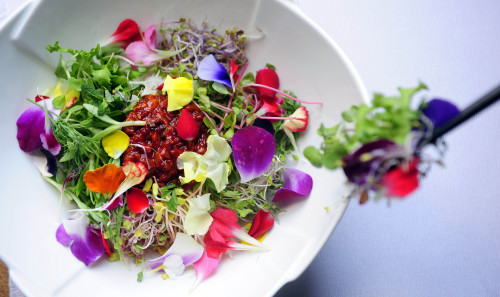Edible blossoms enliven and brighten up meals
Flowers serve as emblems of spring’s arrival, a sign that plants are stirring, birds are warbling and bees buzzing.
Though often used to create decorative bouquets, blossoms at the dinner table are not restricted to the vase. Technicolor petals add a burst of color to a bowl of salad, a frosted cake or even a cheesy slab of pizza.
The Korean tradition of dining on blooms runs as far back as the Joseon Dynasty, when women gathered on Samjinnal ― celebrated every March 3 on the lunar calendar ― to cook hwajeon (sticky rice flour pancakes embellished with edible posies).
Fried zucchini blossoms are an Italian summer staple, while in the Middle East, rose water is worked into desserts. According to Angel Farm CEO An Seung-hwan, who started growing organic edible flowers in 1995, the Japanese have managed to extensively develop a wide repertoire of dishes based on cherry blossoms.
An explained via email why we are compelled to put flowers in food: “First of all, they are quintessentially beautiful. Furthermore, they are packed with beneficial nutrients.”
Blossoms boast vitamins, minerals and are believed to help with an array of ailments. For example, both pansies and chrysanthemums are taken to beautify the complexion and roses contain vitamin C.
Flowers serve as emblems of spring’s arrival, a sign that plants are stirring, birds are warbling and bees buzzing.
Though often used to create decorative bouquets, blossoms at the dinner table are not restricted to the vase. Technicolor petals add a burst of color to a bowl of salad, a frosted cake or even a cheesy slab of pizza.
The Korean tradition of dining on blooms runs as far back as the Joseon Dynasty, when women gathered on Samjinnal ― celebrated every March 3 on the lunar calendar ― to cook hwajeon (sticky rice flour pancakes embellished with edible posies).
Fried zucchini blossoms are an Italian summer staple, while in the Middle East, rose water is worked into desserts. According to Angel Farm CEO An Seung-hwan, who started growing organic edible flowers in 1995, the Japanese have managed to extensively develop a wide repertoire of dishes based on cherry blossoms.
An explained via email why we are compelled to put flowers in food: “First of all, they are quintessentially beautiful. Furthermore, they are packed with beneficial nutrients.”
Blossoms boast vitamins, minerals and are believed to help with an array of ailments. For example, both pansies and chrysanthemums are taken to beautify the complexion and roses contain vitamin C.

Visual allure and health-giving bonuses may be the greatest draw posies have to offer, but they also prove interesting to eat in terms of flavor and texture.
An says that nasturtiums are spicy, snapdragons are bitter and begonias (the edible variety) sour, making them good for salads.
To see what An is talking about, The Korea Herald decided to take the petal for a palate-loaded test drive and visited the Courtyard by Marriott Seoul Times Square’s MoMo Cafe where a two-month long herb and flower event is underway.
Posies of five different varieties were strewn over pizza and Korean-style barbecued beef, and mixed into an unrecognizable tangle in a spicy sea squirt bibimbap dish.
Of the three, the bibimbap ― with its briny, ocean-laden, slightly sour tang from the pickled sea squirt ― sent an eye-opening, zinging slap to the senses, combining the crunch of spring greens and blooms with the piquant, mouth-puckering seafood and an accompanying soy sauce-based dressing.
The pizza won hands down for best floral experience. A liberal topping of sprigs of ruby, violet and yellow not only added vibrant color to the dish but also a strange textural experience, whereupon it was discovered that pansies are not only edible rags of velvet but also sugary sweet to boot.
“This is our first flower-driven event,” said Courtyard by Marriott’s head chef Richard Oh, who said he is sourcing his buds from a farm that specializes in edible flowers. “The response has been good so we are thinking of doing it again next spring.”
Not every flower is meant for consumption, some are poisonous, so it is important to be careful when buying blooms. In other words, do research or consult with an expert in advance. Avoid posies that have not been proven edible and that have not been cultivated by experts.
Angel Farm’s An warns against eating flowers raised for decorative purposes. Blossoms meant for bouquets and not for dinner may have been sprayed with pesticides or chemicals. The 58-year-old CEO also stressed the importance of purchasing from farms that specialize in edible flowers.
Before using in food, clean off pollen, remove pistils, stamens, calyx and stems and wash in water, because certain edible flowers may contain a small amount of toxins in the stamen. If allergic to flowers or pollen, it is advisable to exercise caution and consult with a physician.
By Jean Oh (oh_jean@heraldcorp.com)








![[Graphic News] More Koreans say they plan long-distance trips this year](http://res.heraldm.com/phpwas/restmb_idxmake.php?idx=644&simg=/content/image/2024/04/17/20240417050828_0.gif&u=)
![[KH Explains] Hyundai's full hybrid edge to pay off amid slow transition to pure EVs](http://res.heraldm.com/phpwas/restmb_idxmake.php?idx=644&simg=/content/image/2024/04/18/20240418050645_0.jpg&u=20240419100350)






![[KH Explains] Hyundai's full hybrid edge to pay off amid slow transition to pure EVs](http://res.heraldm.com/phpwas/restmb_idxmake.php?idx=652&simg=/content/image/2024/04/18/20240418050645_0.jpg&u=20240419100350)

